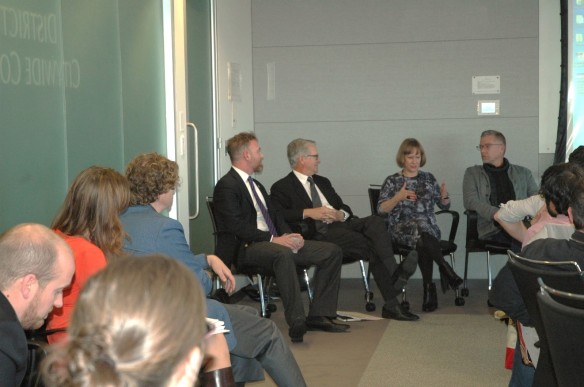Date: November 13, 2015
Location: One Judiciary Square
441 4th St. NW, South Lobby 11th Floor, Conference Room 1112
Time: 12:00 pm – 5:00pm
Led by: Tyler Ashworth, AIA, NCARB, LEED AP BD+C & Vinson Camacho, Assoc. AIA
Summary:
Session #2, entitled “Entrepreneurship and Firm Management” was organized and hosted by Tyler Ashworth and Vinson Camacho and held at the District of Columbia Department of General Services. Tyler and Vinson addressed the theme by inviting a variety of guest speakers to impart their wisdom on the CKLDP scholars through a series of talks, pecha-kucha style presentations, a break-out session, and reflective discussions.
The day began with a brief presentation by Ms. Patricia Harrison, a Business Development Specialist with the District of Columbia Department of Small and Local Business Development. She touched on the wide variety of government resources available for small businesses in the District and the opportunities that come with being a Certified Business Enterprise (CBE).
The second talk was given by Shannon Kraus, managing partner at HKS, Inc., who encouraged the group to “Be Entrepreneurial” not by developing a particular skillset, but by cultivating an attitude of embracing risk. Kraus challenged the group to identify their passion and use that as motivation to live outside themselves and continue to evolve. Kraus described how you can be good at something for about five years, and that’s when you hit your peak. To avoid lingering within your comfort zone, you must reflect on your trajectory, explore new paths, and reinvent yourself. To illustrate this, Kraus summoned the cautionary tales of companies who were once ground-breaking in their fields but over time failed to take risk and ultimately succumbed to more entrepreneurial competition. He concluded his talk by reviewing an insightful list of things to invest in as a leader, and things to avoid.
The Panel Discussions focused on firm management strategies and were broken down into four segments of pecha-kucha style presentations discussing the topics of transition and firm leadership, financial management strategies, project management tools, and the use of data and analytics in business strategies. The invited guests included some of DC’s top firm leaders representing both small and large architectural practices – David Shove Brown, AIA, Partner of // 3877; Yolanda Cole, AIA, IIDA, Senior Principal of Hickok Cole Architects; Steve Parker, AIA, Chairman, Co-Founder of Grimm + Parker; and Chris Morrison, FAIA, Managing Director of Perkins + Will. Each provided valuable insight and guidance to anyone engaged in firm management and entrepreneurship.
Highlights of the presentations included the recommendation to establish a clear vision for your business and a strong strategic plan. Being an entrepreneur involves proper planning and understanding of your financial risk. Early planning includes establishing contracts and stakeholder agreements, which maintain a professional business relationship and outline essential processes and procedures, such as exit strategies and management transitions.
It is essential to develop good communication skills, both within your team and project manager, and with your clients and user groups. As leaders of a firm you must mentor and empower the future leaders of your organization, providing them the path to leadership opportunities and professional growth. It is critical to build a supportive team with a diversity of talents, skills, and viewpoints. Finally, one must always monitor your progress, analyze the data, and be flexible to make adjustments and changes when necessary – be nimble and establish tangible goals.
Following the Panel Discussions the CKLDP class was broken down into 4 small groups and paired with one of the firm leaders. Each team was provided with a hypothetical business problem or challenge to develop suggested strategies for resolution. Each scenarios was related to the firm management strategies discussed. Following small group discussions, each group presented their thoughts and recommendations as they pertained to options for firm ownership and management transitions; assessment of firm growth, productivity, and finances; project management and communication strategies; and understanding market analysis to inform and improve practice sectors.





